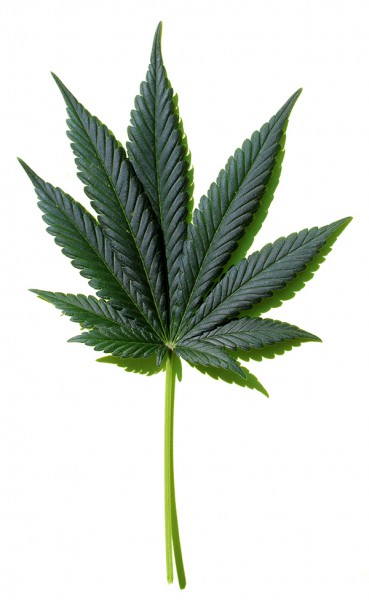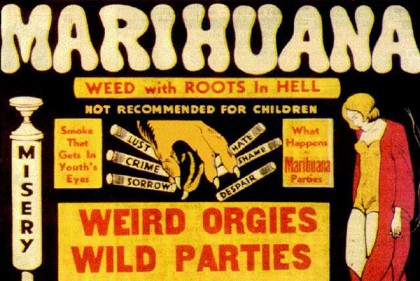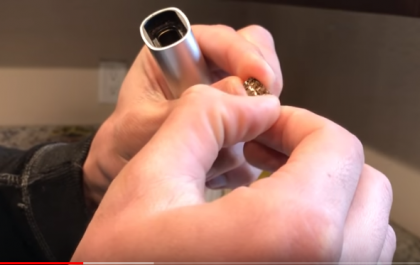Marijuana Myths
1. Marijuana is more harmful than tobacco
A lot of citizens believe that smoking marijuana is just as bad as smoking tobacco, however this couldn’t be farther from the truth. First of all marijuana smokers are not ingesting the leaves of the plant, but instead the bud. The bud itself contains one third the amount of tar as tobacco. Cannabis also does not cause your air passageways to tighten up and narrow like tobacco does.
2. Marijuana is a gateway drug
Everybody has heard this old argument since Nancy Reagan’s failed “just say no” campaign. Many of us were fed the propaganda by the prohibitionists that marijuana is addictive as cocaine, and heroin. While the weed does still maintain the top Schedule 1 status on the DEAs list (cocaine and meth are Schedule 2: so by their logic they are actually safer) most everyone knows that marijuana is actually much safer. Imagine if your dad and his buddies were sitting around one evening and started talking about the good old days when they used to shoot smack. Wouldn’t happen.
The “gateway hypothesis” started as a marketing ploy by the prohibitionists and was based upon a bogus report which was done by the Center on Addiction and Substance Abuse (CASA). In the report they claimed that marijuana users were 85 times more likely than non smokers to try cocaine. Sounds crazy right? Well, that’s because it is. Let’s look a little but further as to how this study was conducted to uncover the true intent of the study.
The figure was taken from NIDA’s 1991 National Household Survey on Drug Abuse. They cooked up the number by dividing the porportion of marijuana users who have tried cocaine (17%) with the porportion of cocaine users who have ever tried marijuana (.2%). Yeah, that’s right, the group of individuals studied to see if marijuana is a gateway drug wasn’t cannabis smokers. It was just those who were currently using coke. But it gets worse, and even more unscientific. So, because these numbers were so unsubstantial they created another group which studied marijuana smokers. This was actually taken out of the original report. According to the CASA’s study on whether or not marijuana was a gateway drug they found that 83% of marijuana users would never go onto using Cocaine.
You can see why this fact was removed from the final report (it was later reported after a freedom of information request made the entire report public). It invalidated the findings which they were sponsored to reveal. One tricky thing with government funded scientists is that they are caught in a catch 22 situation. If they act as scientists and just give authentic data, they could lose their job because the President (or whoever sponsored the study) has a certain platform which they want to use politically. In this case they chose to remove the data which showed that that only 17 percent of those who used marijuana would go on to using cocaine. Now, 17 percent may still seem like a large number. But if you subtract the total percentage of those Americans who use cocaine currently (about 5% and currently growing again). So you subtract that number from the 17 percent, and you end up with 12. Which means about one in ten marijuana smokers will use cocaine, while one in 20 Americans .
So now you may be thinking “well that’s twice as many people! That shows that you’re twice as likely to try coke after smoking marijuana!” Wrong again. If one did a study of how many cocaine users also smoke cigarettes you actually get a higher number! Cigarette smokers constitute about 25% of the US population which means that cocaine users are 5 times more likely to try cocaine than marijuana smokers. If you want to take it a step further you can as well. And ask, how many cocaine users started altering their consciousness first with alcohol? This skyrockets the figure to nearly 100%. Which, by their own logic would mean that alcohol is 100 times more of a gateway drug than marijuana.
The rabbit hole goes even further because it is now currently the Alcohol Industry which is fighting against marijuana legalization in California. They are afraid that the number 2 most used recreational drug (cannabis) will take a bite out of their profit margins. However, we’ll never see a report on Alcohol as a gateway drug. Why? Because they have hundreds of well paid lobbyists and it isn’t politically expedient.
3. Marijuana causes brain damage
This one is so easy to debunk that it’s almost funny. Well, it would be funny if it didn’t involve killing a monkey by asphyxiation.
The “study” which has now become urban legend is called the rhesus monkey study by Dr. Robert Heath. It was conducted in the late 1970s. The study was reviewed by a group of individuals from the Institute of medicine, and the the National Academy of Sciences. The study was called “Marijuana and Health” and was released in 1982. Heaths work was slammed for a variety of reasons. One was that he only used four monkeys to test on. This is simply to small of a sample to get any credible data. He also skipped an otherwise common Scientific procedure. He also failed to control experimental bias. It gets worse, it turns out he also couldn’t identify what a normal functioning monkey brain looked like. Not joking. He was a stooge put out by the government to try and rationalize their insane Prohibitionist tactics. So, he got his paycheck and needed to get some results. The right results. He strapped devices similar to gas masks over the monkeys mouths and then he began pushing in mass quantities of smoke into them. They received no oxygen during this process. Imagine taking a huge bong hit, exhaling, and then taking in another right after it. You’d probably want to catch your breath right? But these monkeys were not allowed too. For hours he pushed the smoke into their lungs and he burned up literally pounds of marijuana. After 4 grueling hours the last monkey finally collapsed. After their dead bodies were removed from the chairs they were strapped into: they were taken and autopsied. This is the point where Dr Heath made the case that the “smoke” had damaged their brain (even though he couldn’t even identify what a healthy monkey brain looked like).
If you’re not convinced yet you can also look at the report done by a distinguished panel of Scientists at the actual studies of human populations of marijuana users have shown no evidence of brain damage. For example, two studies from 1977, published in the Journal of the American Medical Association (JAMA) showed no evidence of brain damage in heavy users of marijuana. That same year, the American Medical Association (AMA) officially came out in favor of decriminalizing marijuana. That’s not the sort of thing you’d expect if the AMA thought marijuana damaged the brain
4. Marijuana use is increasing at an alarming rate
Isn’t this always the case?!? By the number of stories you see year after year about the “alarming increasing rate of marijuana use” you’d think basically the whole country was constantly stoned. Drug use rates go up and down all the time. Currently they are actually going up amongst middle aged smokers, but are staying pretty level for teens and younger people. This is largely due to the fact that marijuana dispensaries are getting more and more common and individuals who were scared to go to a drug dealer can now go to a friendly guy sitting at a counter full of buds. And in many states if you have a medical marijuana card it’s legal. It’s very easy to disprove any claims about growing trends. The people who generally make these accusations are those who are looking to receive more federal funding to fight the drug war. Here’s some sobering statistics. Today 34.3% of high school seniors claim to have smoked pot in the last 12 months which is down from 52.8% in 1976, 50.9% in 1986, and just barely higher than the 33.1% of 1996.
Drug use popularity is constantly in flux. Much like the stock market. 40 years after the war on drugs began we’ve seen little change besides millions of ruined lived and hundreds of billions of tax dollars wasted. The rates go up, then they come down again.
5. Marijuana is more potent today than in the past
Yes. This has some truth to it, but it still wrapped in bullshit. Marijuana cultivation techniques and strains have given us bigger, fatter, and stronger buds. Maybe there are a few old timers who got some ridiculous stuff in the past but it pales in comparison to the vast majority of weed available on the market today. However, one big thing really changed and that is that it wasn’t until the 1990s when “buds” started becoming popular. Back in the 60s, 70s, and 80s, people still commonly chopped up the plant with all the leaves, stems, and flowers. Today the leaves and stems are used to make hash, and the buds are sold separately. People also used to inhale much more smoke whereas today most smokers don’t have more than a few small hits on a pipe. So the effects are similar, the amount smoked has decreased.
6. Marijuana is an addictive drug
Oh boy. This is one of the most insidious lies about marijuana floating out there. First of all there are two types of addictions. Physical, and mental. It is absolutely impossible to become dependent on marijuana. IMPOSSIBLE. The substance doesn’t act the same way other drugs do in the body. Most drugs rely on the brain producing something called Dopamine which releases a pleasurable endorphin into the body. Marijuana users are activating the Cannabinoid receptor part of the brain (that’s right, there’s a section of the brain which is devoted to processing Cannabis). The amount smoked is the easiest indicator to dispel this myth. Cannabis users generally don’t steadily increase the amount that they smoke. A long term user may smoke more than a first time smoker but this has more to do with how comfortable they are with smoking rather than tolerance. With coke, heroin, meth, coffee, and cigarettes the user needs to steadily increase the amount used to achieve the same results. This is because of how the body works, and how addictions are formed that ruin lives. As an addict continues to use more and more, the body gets more beat up and the user begins to ignore these problems because they need more drugs. Soon 50 dollars isn’t enough to score for a day, a hardcore cocaine addict may need 500$ to stay rolling. But this cascading downward spiral never occurs with marijuana users. Simply because they don’t need more drugs to get high. It should also be noted that once a long term marijuana smoker quits for a few days there are virtually no side effects and withdrawls. compared to Heroin, Alcohol, and even Cigarettes, marijuana is extremely easy to quit because the physical body doesn’t crave it. The mental side may however.
The second part of this marijuana myth revolves around the idea that “there are more and more young people going into rehab for marijuana use than any other drug”
This is so easy to debunk it’s laughable. First of all. Marijuana is the most used drug, so of course the numbers will undoubtedly be higher. And secondly, most juveniles are forced to go to rehab in lieu of going to jail. They go and sit and listen to the bullshit spouted by the prohibitionists. They get out, and continue to use just as before. That’s because they know nothing is wrong with it. There is however a danger in having people in authority spreading these lies about marijuana. A young person who gets caught with a joint may go through a drug rehab program where they are filled with all sorts of misinformation. The juvenile may then begin to think that all the other information about other drugs are lies as well. These individuals are more likely to use hard drugs because they have lost faith in the system. While marijuana isn’t harmful in any way, the same can’t be said about Methamphetamine. There’s also a reason why there isn’t a “Heroin Times” magazine. They’re completely different drugs and should be treated as such. Drug rehab programs for juveniles actually increase the probability that they will go on to use harder substances.
7. Marijuana damages the reproductive system – This claim is based chiefly on the work of Dr. Gabriel Nahas, who experimented with tissue (cells) isolated in petri dishes, and the work of researchers who dosed animals with near-lethal amounts of cannabinoids (i.e., the intoxicating part of marijuana). Nahas’ generalizations from his petri dishes to human beings have been rejected by the scientific community as being invalid. In the case of the animal experiments, the animals that survived their ordeal returned to normal within 30 days of the end of the experiment. Studies of actual human populations have failed to demonstrate that marijuana adversely affects the reproductive system.
8. Marijuana suppresses the immune system – Like the studies claiming to show damage to the reproductive system, this myth is based on studies where animals were given extremely high — in many cases, near-lethal — doses of cannabinoids. These results have never been duplicated in human beings. Interestingly, two studies done in 1978 and one done in 1988 showed that hashish and marijuana may have actually stimulated the immune system in the people studied.
9. Marijuana smoke contains over a thousand chemicals – True but very misleading. The 31 August 1990 issue of the magazine Science notes that of the over 800 volatile chemicals present in roasted COFFEE, only 21 have actually been tested on animals and 16 of these cause cancer in rodents. Yet, coffee remains legal and is generally considered fairly safe.
10. Marijuana is a drug without therapeutic value – Proposals to make marijuana legally available as a medicine are countered with claims that safer, more effective drugs are available, including a synthetic version of delta-9-THC, marijuana’s primary active ingredient. For thousands of years, throughout the world, people have used marijuana to treat a variety of medical conditions. Today, in the United States, such use is prohibited. Although 36 states have passed legislation to allow marijuana’s use as a medicine, federal law preempts their making marijuana legally available to patients. People undergoing cancer chemotherapy have found smoked marijuana to be an effective anti-nauseant – often more effective than available pharmaceutical medications. Indeed, 44% of oncologists responding to a questionnaire said they had recommended marijuana to their cancer patients; others said they would recommend it if it were legal. Marijuana is also smoked by thousands of AIDS patients to treat the nausea and vomiting associated with both the disease and AZT drug therapy. Because it stimulates appetite, marijuana also counters HIV-related “wasting,” allowing AIDS patients to gain weight and prolong their lives.







